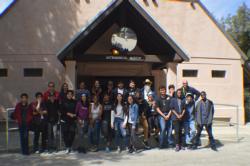

A Night Under the Stars
On the weekend of March 18th and 19th, eighteen juniors and seniors from MSA-3 Carson went on an overnight field trip to the Mount Wilson Observatory. This is the first time that the observatory, working with Carnegie Institution of Science, has conducted a trip of this kind. Our MSA-3 students immersed themselves into the experience, and learned a lot about astronomy and science through inquiry based activities.
On the weekend of March 18th and 19th,
eighteen juniors and seniors from MSA-3 Carson went on an overnight field trip
to the Mount Wilson Observatory. This is the first time that the observatory,
working with Carnegie Institution of Science, has conducted a trip of this
kind. Our MSA-3 students immersed themselves into the experience, and learned a
lot about astronomy and science through inquiry based activities.
Students started their experience with a historic tour of
the grounds and telescopes, followed by an astronomical objects inquiry lesson
in the auditorium, a sunset viewing using the Lunt telescope, and enjoyed a
night under the stars while looking through the 60-inch telescope. The trip also
included a rare and unique experience where students remotely activated a telescope in Las Campanas, Chile where they did
narrow wavelength observations of the tarantula nebula (aka 30 Doradus). The
views were stunning!
The overnight trip to Mt. Wilson
Observatory was a first for Magnolia Public Schools, but based on the amazing
experience our MSA-3 students this definitely will not be the last.
About Mt. Wilson
Observatory – STEM Educational Programs
Students in the Los Angeles area have the unique opportunity
to visit the mountaintop where humanity discovered its place in the
Universe–from our position in the Milky Way to Hubble’s observations, proving
our galaxy is one of billions, all in an expanding Universe. At Mount Wilson,
an astronomer from Carnegie Observatories or NASA’s Jet Propulsion Lab will
teach your students–at any level–about the astrophysics that led Hubble to
discover the expanding Universe. What better place to learn about the Big Bang
and other STEM core topics, than standing next to the historic 100-inch
telescope that Hubble used? Come visit all our telescopes, the 100-inch
Telescope (which celebrates its centennial this November), the 60-inch
Telescope, the Snow Solar Telescope, and the 60 and 150-foot Solar Telescopes.
In addition to these historic instruments, which revolutionized astronomy
during the first half of the 20th century, we also have CHARA array, completed
in 2004 and operated by Georgia State. This array of telescopes has the highest
resolution of any telescope system ever built, including those in space. It has
recorded spots rotating on distant stars.
So bring your students for a visit. Einstein came and so did
Stephen Hawking and Carl Sagan. What better place to get inspired to learn more
science?
If you would like to learn more please
visit: https://www.mtwilson.edu/school-field-trips/